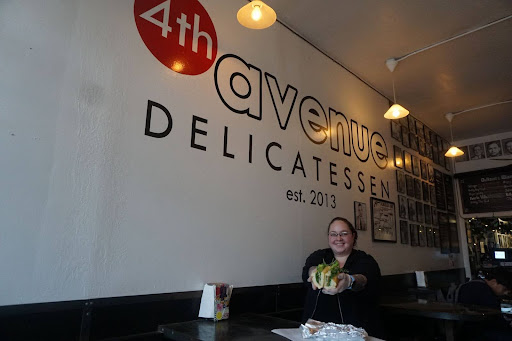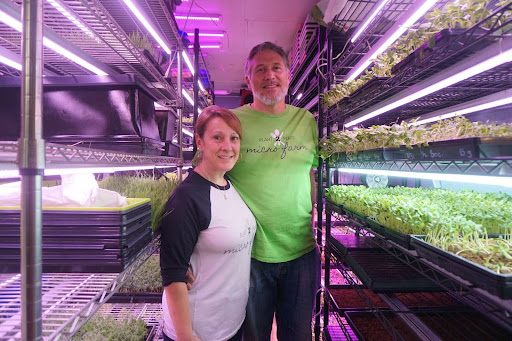It was the 1980s in San Francisco. Microgreens were the new, fashionable gourmet vegetable. Not quite a sprout, not quite a full-grown vegetable either, these high-value greens started to be featured in chefs’ menus across the city.
Now, microgreens are not only in the San Francisco gourmet restaurant scene but gaining familiarity worldwide. In Tucson, they’re starting to become available in chain grocery stores like Trader Joe’s or Sprouts and also through many local producers in or near town.
“I would say in the last 10 to 15 years […], as we approach the present, its popularity is increasing exponentially,” Joel Cuello, University of Arizona professor of agricultural and biosystems engineering, said.
So, what exactly are microgreens?
Microgreens are “just baby versions of bigger edible plants,” with only “the first stem that sprouts out of a seed that has [its] first two leaves on it,” according to local Tucson microgreen farm Plant 2 Plate’s website.
They are vegetables harvested after only a few weeks at the seedling stage and are typically 2-3 inches tall but can have anywhere from four to 40 times the nutrients of their mature plants, according to Cleveland Clinic. There are about 50-60 common microgreen varieties, including kale, spinach, peas and radish greens. The plants have a flavor similar to their mature counterparts.
A local and fresh taste
With several microgreen farms in town, some consumers prefer buying the products from local producers rather than from grocery stores.
Marie Gonzalez is one of those people who regularly buy a microgreen variety mix with a bi-weekly subscription from her friend Tria Decker, co-owner of Healthy You Microgreens located in Southeast Tucson.

Unlike store-bought products, the vegetables are typically delivered within the same day or a few days of harvesting, which can result in a fresher taste. Gonzalez said though store prices are slightly cheaper by a dollar or two, she doesn’t mind paying the extra for the difference in flavor.
“When you get them from someone that grows [the microgreens] themselves, there is a different texture and crispness to them that is unmatched,” Gonzalez said.
Creative culinary collaborations
Local farms have also developed close relationships with restaurants in town, such as Plant 2 Plate Micro Farm, owned by husband and wife team Jim and Kathleen Garrett, who supply over 15 Tucson restaurants along with individual orders.
One of these restaurants is 4th Avenue Delicatessen, a sandwich shop located on Historic Fourth Avenue with items named after mobsters, outlaws and gangsters. They began to sell microgreens around three years ago due to popular demand.
“People would ask for them all the time, and we never had any,” Kylie Myers, owner of 4th Avenue Delicatessen, said.
Myers worked with Plant 2 Plate, trying different varieties to find the best flavors that worked with their current sandwiches. They finally decided on two contrasting microgreens: the confetti radish, a colorful and leafy vegetable that had a “peppery” taste, and the pea, which had a “sweeter” taste.
The incorporation of microgreens helped Myers with the creation of the upcoming vegan menu at the time.
“The [microgreens] really just helped pull together the vegan menu and make those sandwiches even better,” Myers said.
Now, along with their classic meat-based favorites such as Billy the Kid and Genovese, all of their vegan sandwiches feature microgreens.

Besides the specific sandwiches, customers also have the option to include either of the two microgreen varieties they offer in any sandwich. Though microgreens are technically not sprouts, the 4th Avenue Delicatessen calls them by the latter due to their similarities and because it is more of a familiar term to the public.
As long as she can get them, Myers said she doesn’t see microgreens leaving the menu anytime soon.
“In the beginning, they were popular, and it was good. Now we sell even more of them, so I don’t see them going away at any time,” Myers said. “Some people are already hooked on their sandwiches, and they order the same one over and over. If I took away the microgreens, they’d be pretty upset.”
Other restaurants where Plant 2 Plate’s microgreens are used include Zio Peppe, Gourmet Girls Gluten Free Bakery/Bistro and Tohono Chul Garden Bistro. Kathleen Garrett said she enjoys seeing what the chefs come up with using their vegetables.
“It’s really fun to have restaurants where the chefs are given freedom to be creative […], and it’s wonderful to see what they create with our greens,” Kathleen Garrett said.

Nutritional benefits
Another focal selling point for microgreens lies in its nutritional value. Eating vegetables, in general, has been shown to improve thinking, lower the risk of heart disease, prevent cancer and protect vision, according to Cleveland Clinic.
Along with already having between four to 40 times the nutrients of their mature plant, the shorter transportation time for local microgreens can result in the nutritional value being better retained compared to its store-bought counterparts. Moreover, our food sources do not have the same amount of minerals and nutrients that they used to in the past due to modern agricultural practices, according to National Geographic.
“So when you’re eating the microgreens, you’re getting above and beyond,” nurse practitioner Crysty Frick said. Frick works with individuals that are nutrient deficient and has a subscription with Plant 2 Plate.
Frick said incorporating microgreens into things like smoothies is an easy way to boost nutrition without supplements. They’re also easily thrown into salads, sandwiches, pesto and used as a garnish in soup, pizza or pasta.
An emerging, sustainable industry
Cuello said the combination of the vegetable having an easier farming process, as well as its value, is a factor for the cropping of new farms.
“It’s real attractive as a crop for growers to grow. Because one, it’s easy to grow and number two, it’s of higher value than most vegetable crops on a per unit weight basis,” Cuello said.
He said microgreens had a “more sustainable production process” through the combination of having a high nutritional value along with the common use of vertical farming for these crops. A typical vertical farm is a warehouse-type building with shelves arranged vertically upwards to maximize land use.
“So your productivity per unit land area is really, really high compared with regular greenhouses,” Cuello said.
Being typically grown indoors, they are protected from pests, almost completely removing the need for pesticides. They are also known to save “tremendous amounts of water,” according to Cuello, through the use of hydroponics, a way of growing plants without the use of soil.
With the growing market, there are now concerns from growers like Vista Microgreens about the predatory pricing from new farms. Vista Microgreens, owned by University of Arizona alum Bobby Richardson, is based in Sierra Vista, located 75 miles from Tucson, and supplies microgreens to places like Time Market and Midtown Vegan Deli and Market.
“These other places will come in […]. They’ll want to grow some trays here and there and sell them and [they] aren’t really concerned too much about ‘we made x amount of money this week and this month’ and stuff like that,” Richardson said. “So it’s become a challenge dealing with that.”
Even with these concerns, it looks like the industry will continue to thrive in the near future, with it currently valued at $1.78 billion as of 2022 and projected to grow to $5.93 billion by 2031, according to IMIR Market Research.
“Even though it’s an emerging industry, it actually is already a thriving and lucrative industry,” Cuello said. “So right now, it really is a recognized crop and it’s only going to grow over time.”
Follow the Daily Wildcat on Instagram and Twitter (X)









